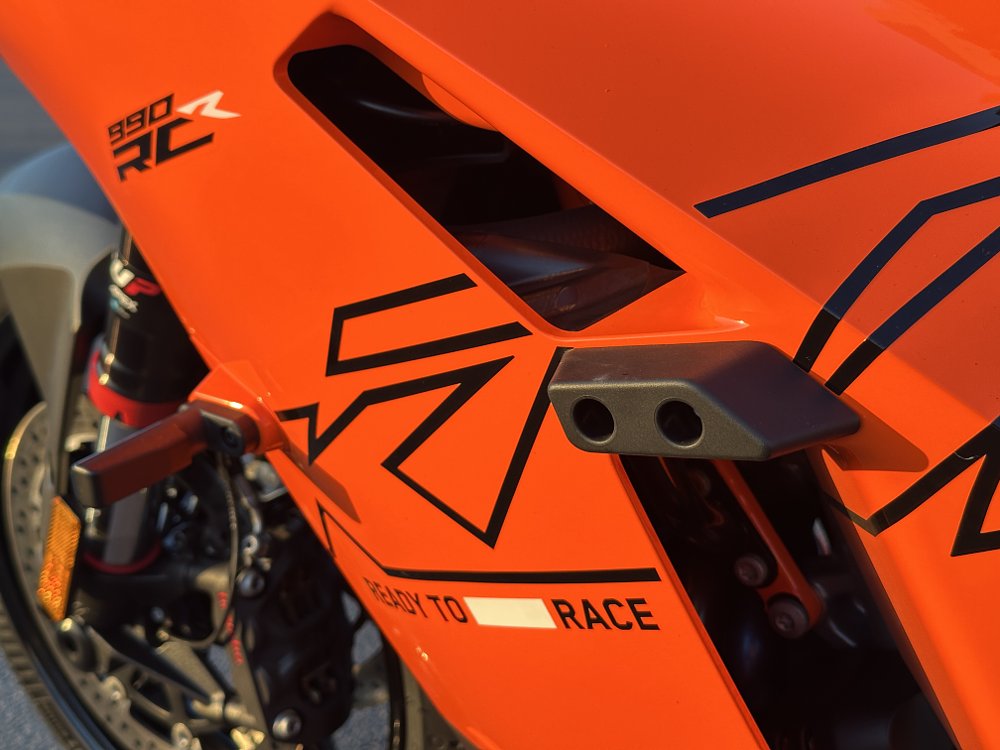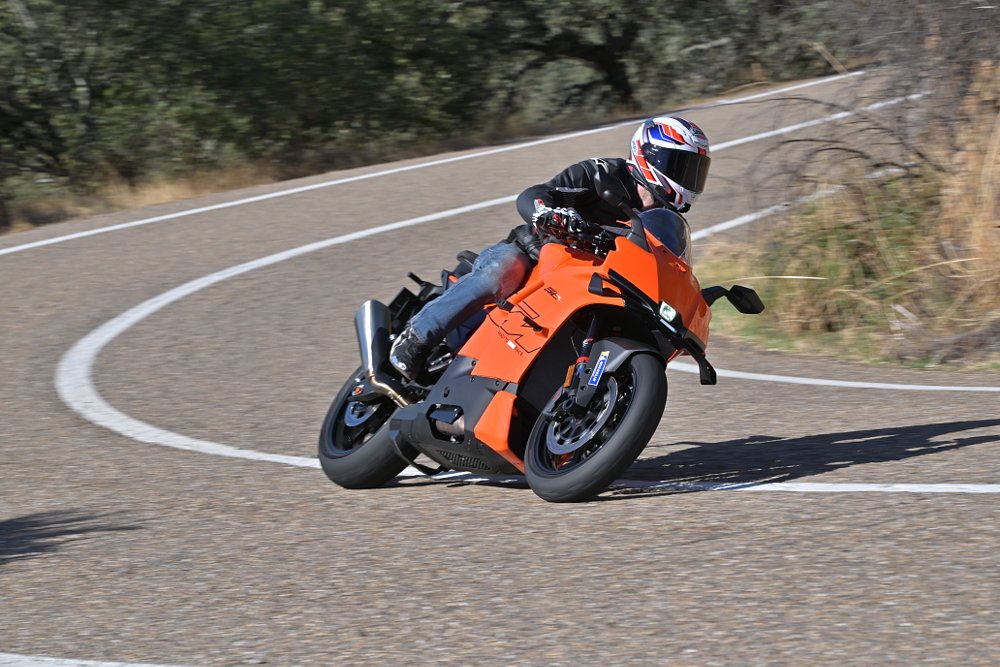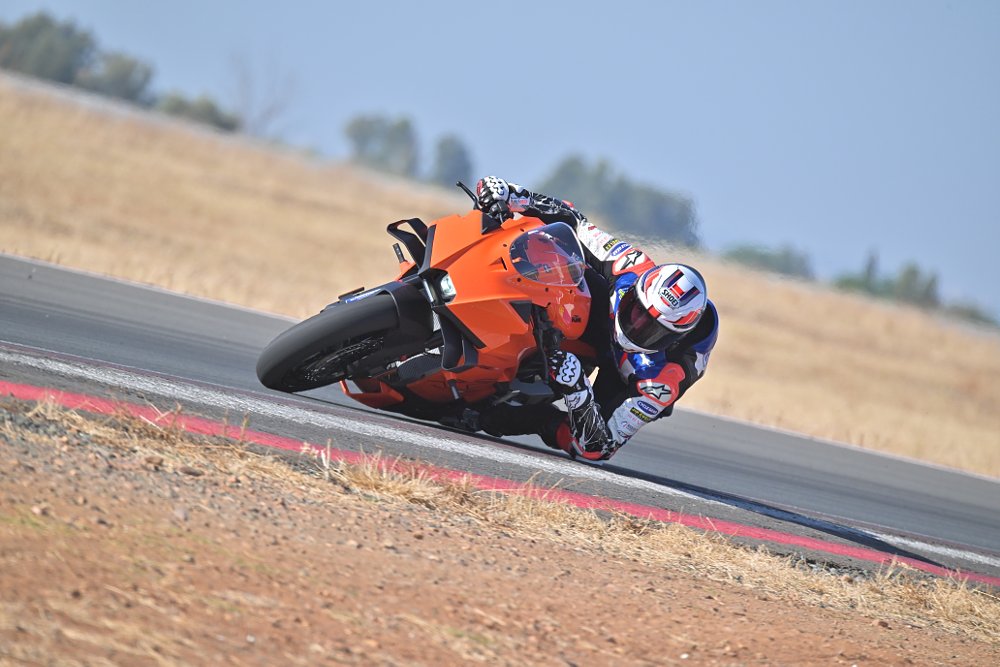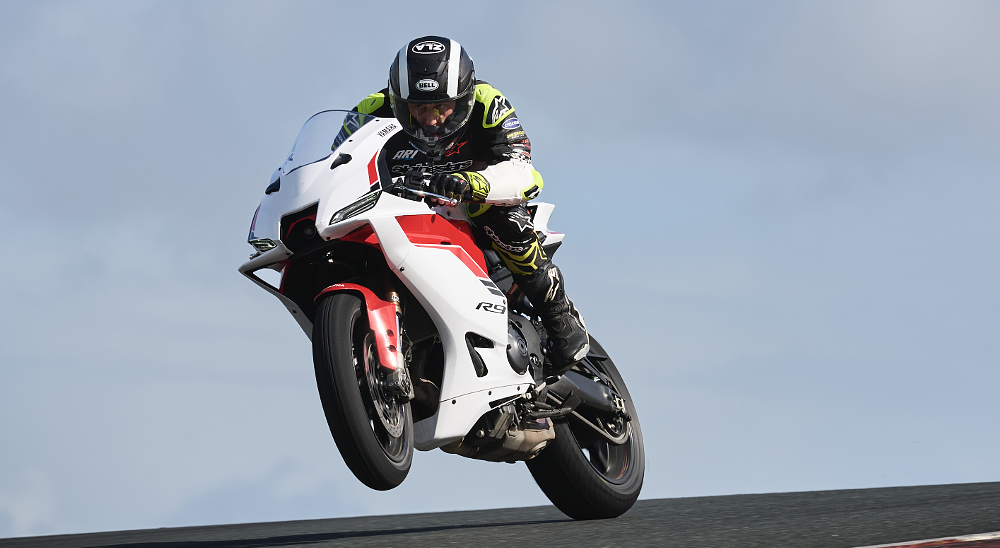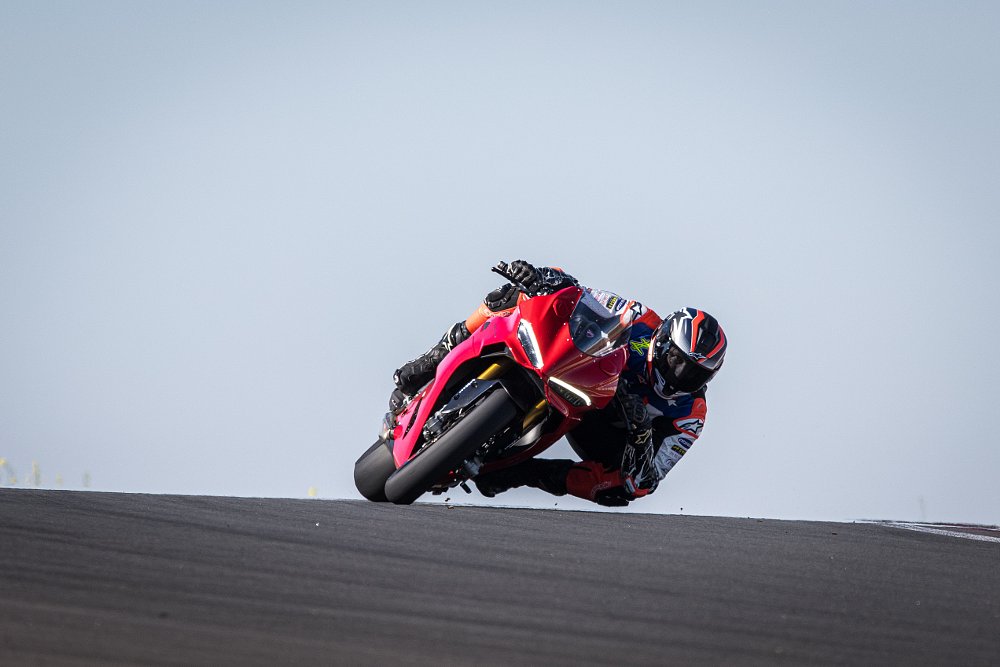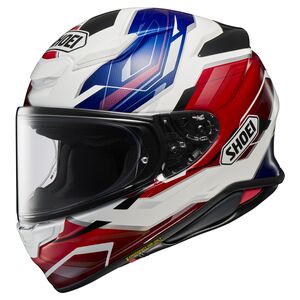Motorcycles are so advanced these days, veteran riders sometimes joke that they’re uncrashable. KTM’s new 990 RC R has nearly every high-tech safety and performance feature that you could hope to find in 2025, and I still managed one of the biggest accidents of my life.
Just like the famous Titanic disaster, and most motorcycle crashes, it wasn’t the fault of the machine. Not mechanically or electronically, anyway. But, the 990 RC R had something to do with why I hit the ground and I reckon it has a little bit to do with how good motorcycles have become.
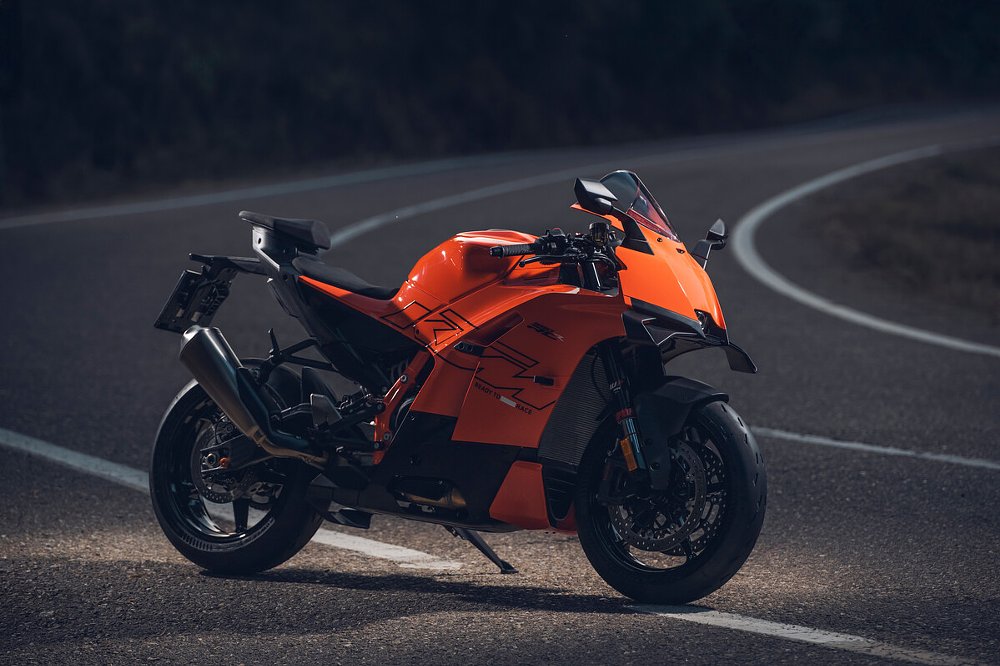
A new age of supersport
Sport bikes are changing, as we have discussed before on Common Tread, with a mostly new crop of midsized sporty machines often taking the place of higher-revving and higher-priced options on dealer showrooms and in consumers’ minds. KTM’s new 990 RC R represents the upper echelon of these machines, with a base price nestled around $15,000 and high-spec features, but the concept is the same — a street-based engine tucked into a sport-inspired chassis, wrapped with racy plastics.
About 10 years ago, KTM axed its 1,195 cc RC8 superbike from the lineup, seemingly declaring to the world that it wasn’t worth the effort. To be fair to KTM, many other full-fledged sport bikes eventually withered on the vine, before being discontinued or falling toward the back of the company’s brochure. The way the KTM team phrases it now, a decade later, is that the RC8 was “the right product, but almost at the wrong time.”
Starting a few years ago, KTM came back around to the idea of a full-size sport bike in its lineup. Some starry-eyed KTM engineer built a prototype machine — an 890 Duke chassis with the then-new 990 engine in it, fitted with clip-ons instead of a handlebar, and bolted up some bodywork for good measure.
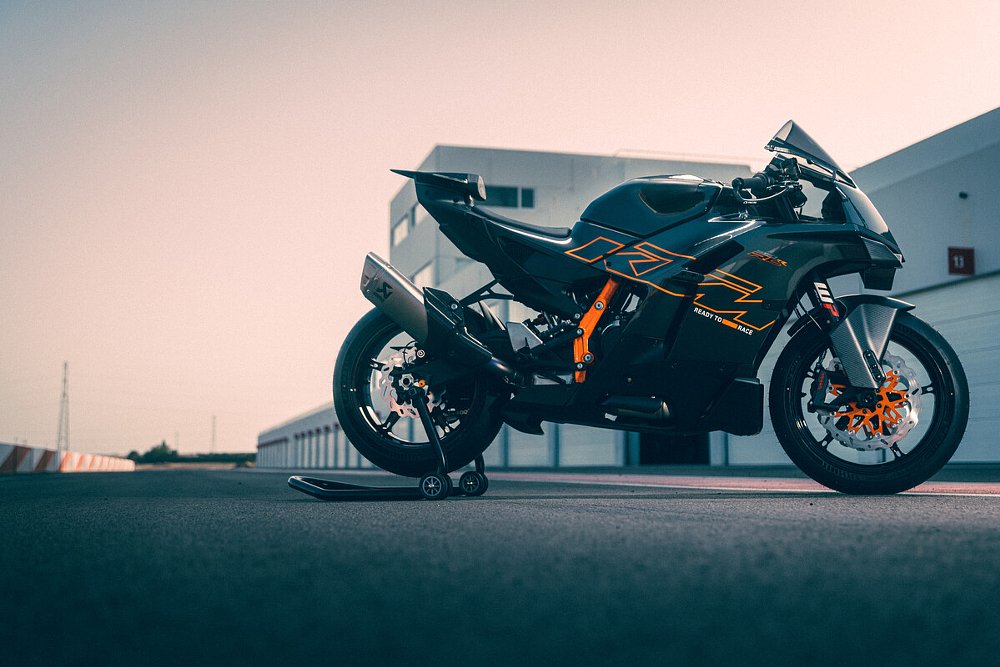
KTM tester Jeremy McWilliams took it for a spin at the next scheduled test, and when he came back with a thumbs up, the team gave the design brief to long-time partners KISKA to draw up a machine that fit the bill. The design team came back with a concept they liked, and then the work began in earnest. About two years later, the final product was ready.
The result is the machine that will go on sale in the United States as a 2026 model 990 RC R. In spite of, and because of, everything that has happened with KTM since the V-twin RC8 was cancelled, the new 990 RC R feels like an important bike. It’s the first full-size, fully faired sport bike that KTM has produced for street use in a decade. The folks in orange are banking on now being the right time.
990 RC R tech details
KTM’s marketing team will proclaim, before anyone asks, that the 990 RC R is “absolutely not” a 990 Duke with lower clip-ons and a fairing. It is “a purpose-built product from the ground up” and “as far from a 990 Duke as it is from an adventure motorcycle.” From a design and development standpoint that might be true, but it’s only fair to mention that a lot of the spec comparisons and anecdotal evidence offered by the KTM team were in reference to the 990 Duke.

The engine is the same between the two models, for example, though the 990 RC R uses different mapping and a different throttle body that now opens all the way (!), as opposed to the 990 Duke. This allows KTM to flaunt the “947 cc engine now boasting additional horsepower and RPM limit.” The wheels are the same and the only reason that the RC R’s wheelbase is longer, as far as I could make out, is that the front end’s triple-clamp offset is 33 mm instead of 32 mm on the Duke.
The 990 RC R’s swingarm is essentially an upgraded version of the Duke’s and the frame’s construction will look pretty similar at first glance. Foundationally, though, where the frame and swingarm meet is where the two models begin to diverge. The RC R’s steel-tube frame holds the swingarm from the outside, opposite the Duke, in part because the rear suspension is quite different.
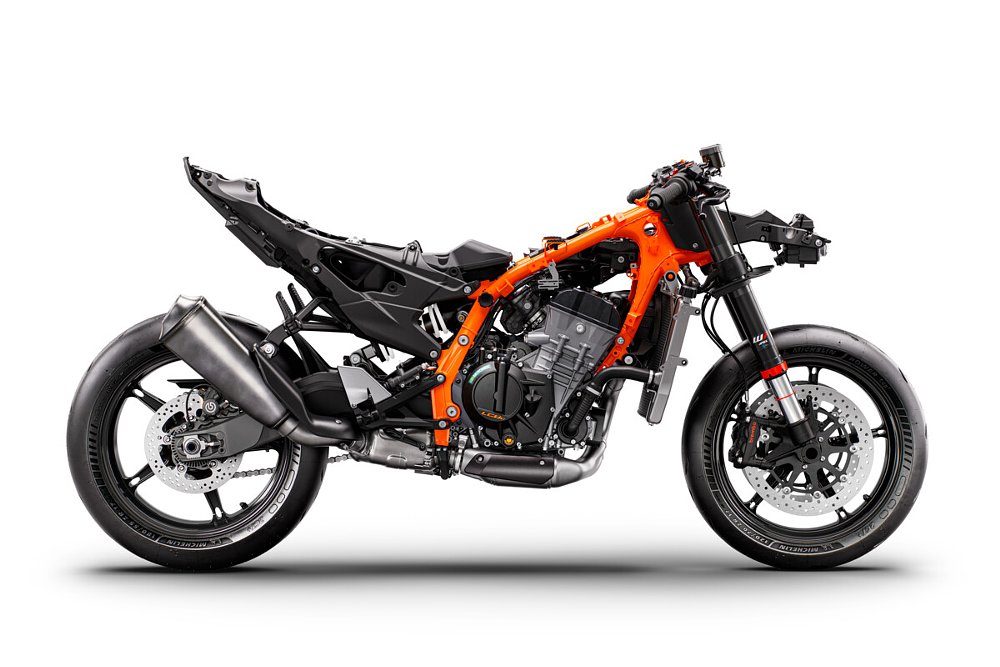
Where the 990 Duke uses a direct-mount system for the shock, the 990 RC R adopts a linkage to provide a more typical, dynamic pressure over the course of the stroke of the rear suspension. In profile, the difference is clear — there’s a lot more clutter between the tail section and the swingarm of the 990 RC R, because the shock linkage is now sharing a room with the massive exhaust collector under the bike.
Outward from there, the 990 RC R is very clearly its own machine. Many of the components are either up-spec or completely new for the debut of the RC R. Brembo’s Hypure calipers are fitted to the front of the 990 RC R, for example, the same kit a buyer gets if they drop double the cash on a Panigale V4.
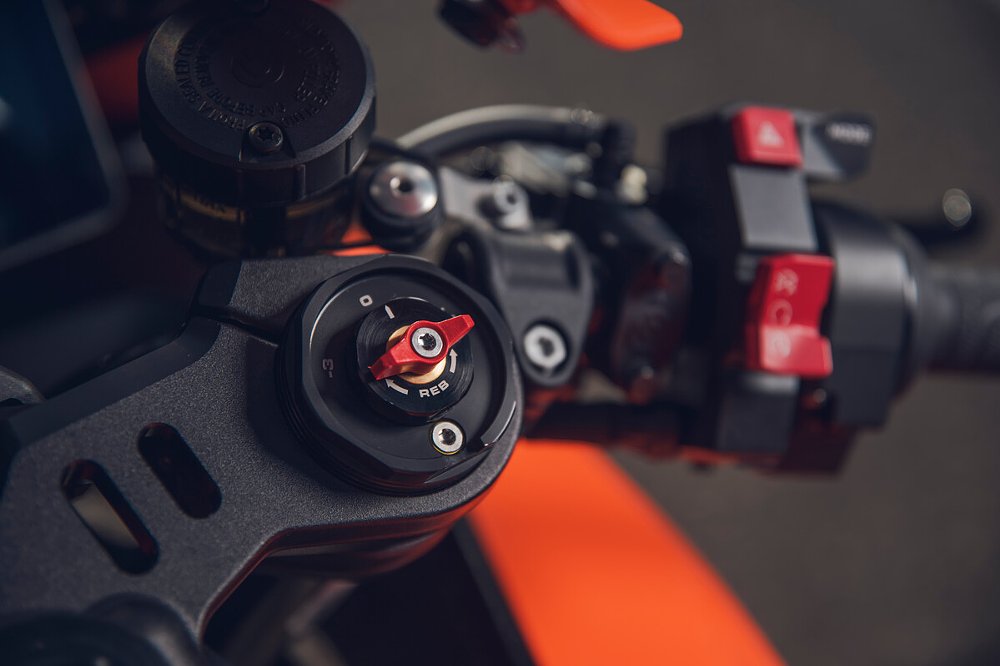
The styling and bodywork is obviously all new, and from my point of view is most interesting for where internal departments ended up in a tug of war. That very prominent aerodynamic mustache on the front of the bike is a perfect example. Design didn’t want them on the bike, but testing had data to show that the approximately 30 pounds of downforce at 150 mph helped the bike go faster. Upper management said function overruled form, and so the wings stayed.
Less obvious and less controversial is the aero deflector mounted on the bike’s belly, just in front of the rear wheel. It is, according to KTM, “not a design-oriented part” but rather a technical one, to stabilize the rear end of the machine under braking.
One of the most conspicuous and glitzy components is the 8.8-inch TFT dash unit crammed into the tightly wrapped fairing of the 990 RC R. The fit is questionable, but beyond that it doesn’t feel gaudy or overengineered. It offers access to all of the electronic mumbo jumbo that you’d expect to find on a state-of-the-art motorcycle in 2025, and for the most part does it cleanly and efficiently.
A four-way joystick navigates the rider through menus for ride modes, bike settings, display themes, and shortcuts for all of the above. KTM kindly offers wheelie-control settings varying from performance focus to “yee haw I wanna show off for my friends” and personally I appreciate that. There are also a few options for rear ABS settings, including a Supermoto+ mode that allows approximately eight degrees of yaw (lateral slide) under braking.
Two things about the dash stood out to me as somewhere between surprising and groundbreaking — touch sensitivity that allows the rider to navigate the dash more like a tablet than a dash screen, and the built-in GPS and navigation software which divorces the need for a smartphone to be paired to the bike in order to see turn-by-turn directions. And wouldn’t you know it, my first impression of the 990 RC R was a street ride.
990 RC R on the road
Over the course of my few hours and 150 miles on the 990 RC R, winding my way through the picturesque hills and unpretentious ag land of southern Spain, I had some marketing material ringing in my head. “This bike is not a compromise” said KTM in the leadup to the launch of the 990 RC R, suggesting that it was the best option for the track as well as the best option for the street. Compromise is the name of the game, though.
Exhibit A, my ride leader (and KTM marketing manager) resting his elbow on the gas tank of the 990 RC R as we trundled through quaint villages in morning traffic. It’s an interpretation every motorcyclist knows, a flag waving that says there’s too much weight on the wrists and the body is tired of it. I participated in the pose at some points during the ride, too.
To be fair, the 990 RC R is more aggressive than I was expecting, especially based on the briefing, but it is far from punishing. Scoot to the front of the seat and you’ll find yourself canted forward to a quasi-racy angle, and with the footpegs in the lowest (and farthest forward) position there’s decent legroom. Clearly a sport bike, in other words, and yet also clearly a departure from the brutal ergos of yesteryear’s supersports.
The reach to the grips is not absurd and the seat is fairly comfortable, but there’s a difference between reaching for a new standard in sport bikes and being straight-up “accommodating.” The 990 RC R has a 33.2-inch seat height and an engine that makes a claimed 128 horsepower — even if it’s not a superbike, this is a halo product meant for those who can appreciate the finer things.
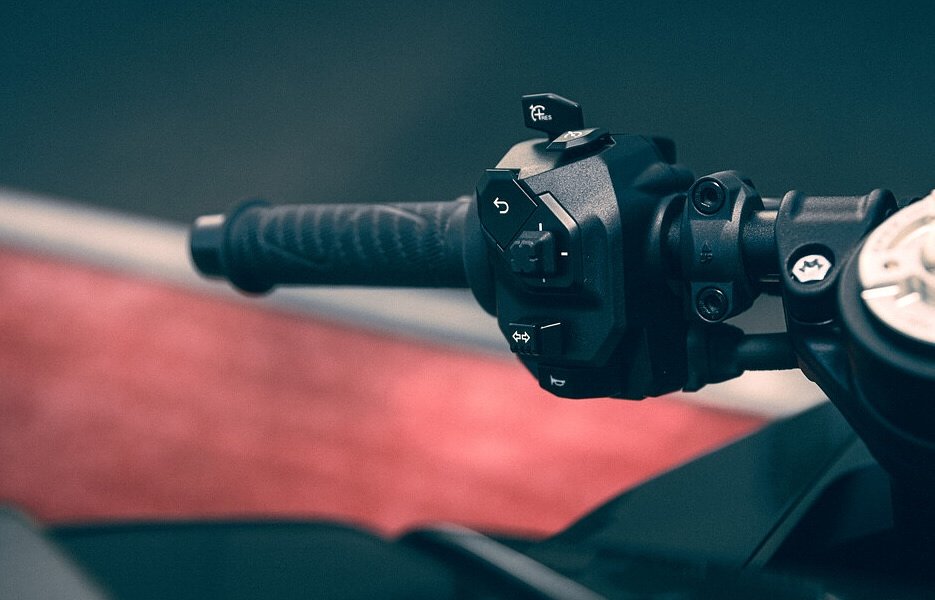
On the topic of finer things, KTM’s 947 cc parallel twin fitted to the 990 RC R is a treat on the road. It is torque-rich and has a beautifully wide swell of mid-range power that left me with no reason to flirt with five-digit revs. With a charismatic thunder coming out the pipe, enough thrust to loft the front wheel, and a few different ride-by-wire options for power delivery, I had very few complaints.
One thing that stood out, though, was heat wafting onto my thighs. It was especially noticeable at low speeds, and surprising given that it wasn’t especially hot on my ride day. The massive bulb of exhaust hardware just behind the engine seemed to be the culprit, more so than the radiator venting out the back of the fairing.
Electronically, I was similarly smitten. The cruise control works great, well worth the $280 KTM is asking, and in general the user experience is clean and easy. Particularly good is the built-in maps, which use HERE navigation on a foundation of MapBox maps and because it doesn’t require a smartphone or app to run, it’s amazingly seamless.
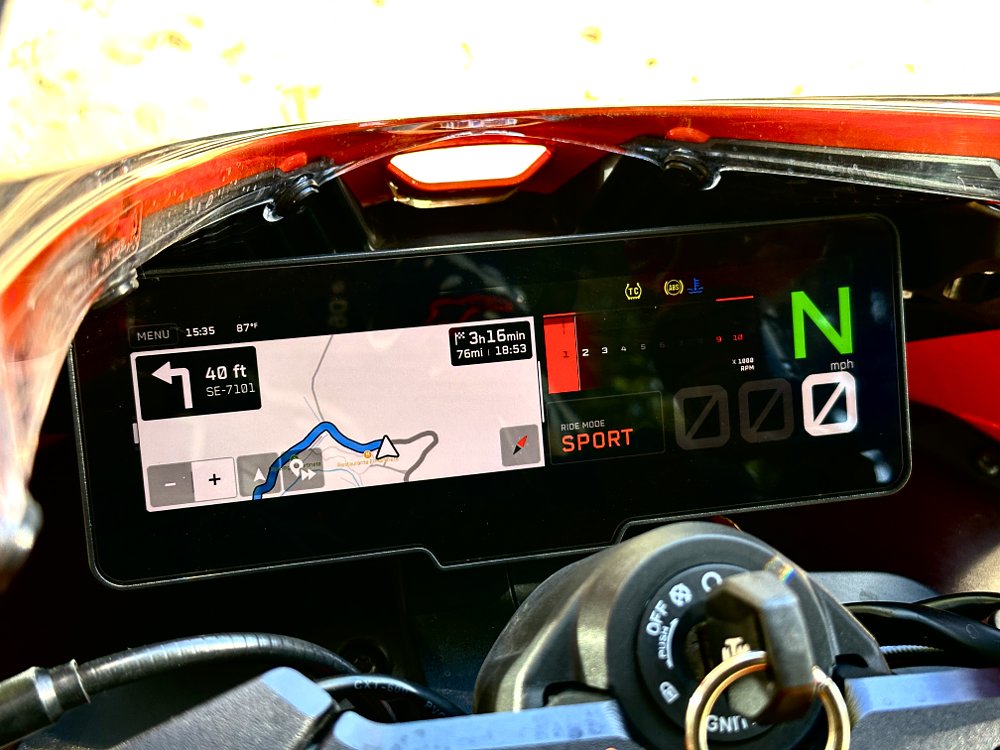
After lunch on the street ride, the gathered press were offered a lead ride back to home base or a self-guided route home using the bike’s software. I took the time to drop some waypoints on a twisty route off the beaten path and set off with the 990 RC R as my guide. Incidentally, how much of the dash used by the nav is adjustable — I just dragged my finger along the touch screen to decide if I wanted the map to take up one-eighth or seven-eighths of the screen, or anything in between.
My route turned out to be questionable. I ended up on some stellar sections of blacktop and also some roads that were full-on ADV territory. Not technically gravel, because I checked the “paved only” box, but sometimes it was hard to tell the difference. The KTM USA staffer who chose to follow me on my route seemed to have more regrets than I did.
If nothing else, it was a good chance to test the suspension, which I thought was totally acceptable. Clicks of rebound and compression damping are changeable via plastic butterfly nuts and easily accessible from the cockpit. I loosened compression damping early in the day of riding and was thankful during the rally stage. There was some disagreement among the assembled press about how soft or hard the suspension felt — to me it was balanced and controlled, without any surprises considering the aim of the bike.
Ultimately, I thought it was a pleasing and unique sport bike, with many more options and higher-spec componentry than I was expecting with a base price of just under $14,000. I did link my phone and headset with the dash, just to experiment, and my music wouldn’t stream cleanly for some reason. Maybe it was Spanish LTE or maybe there was another problem.
My last two notes for my day on the street read exactly how I felt. First, I said “The onboard navigation is such a game-changer. It’s not a great application on this particular bike, but it’s so much better than doing the app/phone-link BS. Kudos to KTM for sorting it out.” Amen. The dash isn’t perfect, but it refreshing in ways I wasn’t expecting.
Last of all, I noted “Overall, for me, it’s not comfortable enough. The handlebars just need to be higher, and the riding position more relaxed. A slightly more extreme product fits the KTM brand, I get that, I just think it’s a miss to not make it noticeably more comfortable than sport bikes have historically been.” Then, importantly, I wrote, “The test will be riding it on track and being honest about whether or not the bars need to be as low as they are for true performance riding.”
990 RC R on the track
This is the short end of the review. Because, what do you expect a moto-journo to say about track performance once they’ve complained that the bike isn’t comfortable on the street? Exactly.
KTM’s 990 RC R feels at home on a race track for most of the reasons I listed in the street portion above. The riding position is somewhat aggressive, the suspension is appropriately stiff, and the engine provides loads of linear power. In fact, I’ll go as far as to say that the 990 RC R feels better than “true” sport bikes of years past, chiefly because it isn’t so severe. I will come back to that.
A few other things stand out, too. The brake system is incredibly good, mostly because there’s lots of power on tap and it never seemed to fade. But also, the bike reacts well under braking. Was it that funky air scoop on the bottom of the bike spiking my confidence? I don’t know, but the ABS isn’t overbearing and even when it’s pushed too hard into a corner the 990 RC R composes itself quickly.
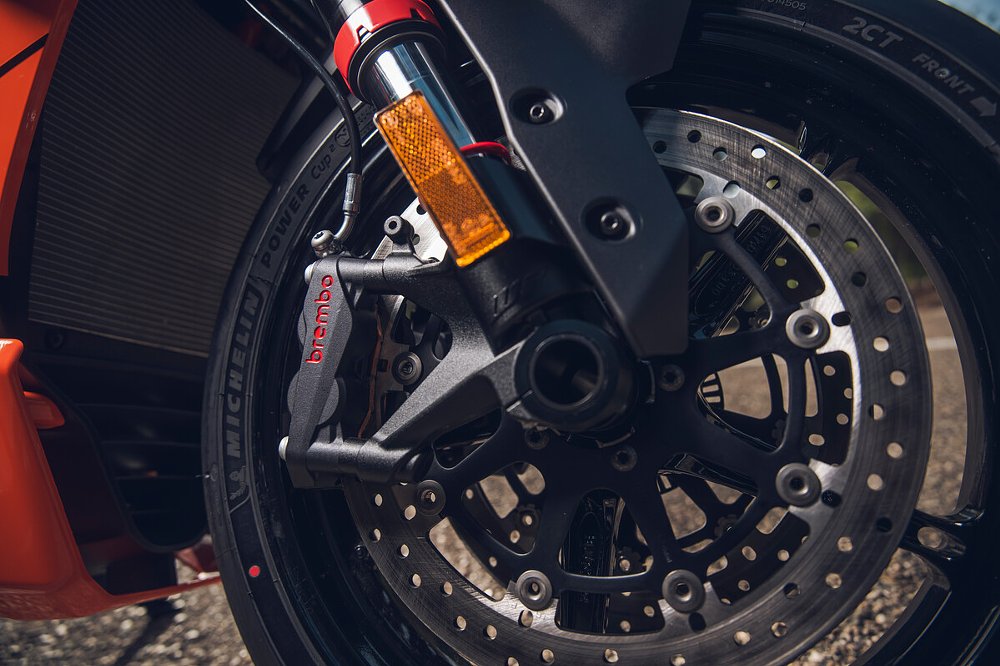
KTM seems to have put a bunch of effort into making the huge and bright dash simple to read in Track mode, and I’d say it was a success. The symmetrical, mirrored bar tachometer that extends out from the edges toward the massive gear-position indicator in the middle of the screen certainly gets the point across, even if the Luddite in me misses an analog needle swinging past numbers.
As a track bike, I think KTM pretty much nailed it. It feels like a proper sport bike, committed but not too much so, and in keeping with the engine size and price point it feels like a full-size motorcycle. Some of my colleagues remarked that the 990 RC R feels bigger (and especially wider) than Ducati’s Panigale V2, and they could be right.
Broadly, it seems to be exactly what KTM promised: plenty of power and an agile chassis to fit the bill. People looking to pick a fight will say that the power flattens off in the upper part of the revs in a way that isn’t befitting of a supersport, and that it’s harder to steer than a “mid size” sport bike ought to be. I think that’s too pessimistic.
At the end of my day at the track, I still felt like the handlebars should be taller. I’m not sure by how much, but if I were king of KTM I would have tried them raised up an inch or so — I have a hunch that tweak would make the bike five pounds better on the street and only a few ounces worse on the track. The opposite take? Former KTM pro Chris Fillmore was on hand to ride with my group, and he said if he were racing the 990 RC R he’d want the bars lower. Compromise is tough.
Still, this is a good motorcycle. Impressive in many ways, solid in others, and with only a few unfortunate quirks. For me, the standout reason that this bike is so good is that it’s easy to use. Pleasant and strong on the street, stable and comfortable on the track. It has massive potential to go fast, but because of the engine’s humble origins and the way that sport bikes are being marketed and built nowadays, it never feels overwhelming. It is premium, but not reckless excess.
The forest for the trees
The inevitable comparisons with Yamaha’s R9 will pour in, and rightly so considering the two bikes are separated by about 10 horsepower and $1,500. If “bang” and “buck” are part of your agenda then we shouldn’t forget about Suzuki’s stalwart GSX-R750, which is only a little more more money than an R9, probably about as (un)comfortable, and will probably get to 150 mph faster than any other bike in the conversation.
Last and most obvious, Ducati’s Panigale V2, which has a higher MSRP and the 890 cc engine is slightly smaller than the 990 RC R, but is also narrower, shorter, and lighter. The comparison between the Panigale V2 and the 990 RC R is interesting for a lot of the gathered press because the test of this new KTM took place at the same track as the Ducati in February. My best lap on the 890 cc Panigale V2 S was a 1:50.2, while my best on the 990 RC R was a 1:48.6.
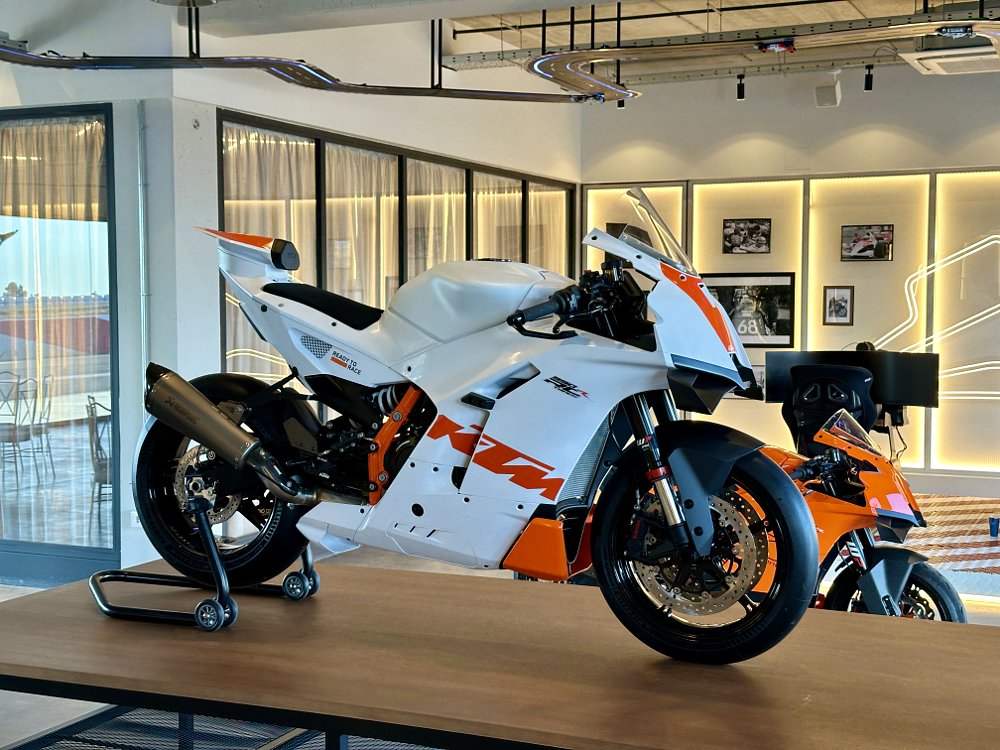
I haven’t ridden the bikes back to back on the road, but my suspicion is that the Pani V2 might be approximately “a second and a half” better as a street bike. Just a hunch. Every bike is a compromise, whether we want to believe it or not. KTM’s 990 RC R is evidence, if you ask me, that we’re compromising less and less as time goes on. If I’m reaching for a flaw, perhaps it’s that the bike made me believe that riding fast was too easy.
Even with traction control, lean-angle ABS, slide control, wheelie control, adjustable suspension, and track-day slicks mounted, I still managed to coax a hugely violent highside out of the 990 RC R. By the time you read this I will have had surgery to reconstruct my ankle and been in a neck collar for about a month to help my fractured C7 vertebrae heal.
Another way to put it is that the new KTM 990 RC R has all of the high-end components and safety features of the most luxurious and powerful motorcycles on the market, with not nearly as much horsepower. That’s a good recipe, I think. The harbinger of a new age of machine, one that will be better for more people. Of course, no company is marketing any of its machines as an unsinkable ship. That’s a mistake that only needs to be made once.
| 2026 KTM 990 RC R | |
|---|---|
| Price (MSRP) | $13,949 |
| Engine | 947 cc, liquid-cooled, eight-valve, parallel twin |
|
Transmission, final drive |
Six-speed, chain |
| Claimed horsepower | 128 @ 9,500 rpm |
| Claimed torque | 76 foot-pounds @ 6,750 rpm |
| Frame | Steel tube, engine as a stressed member |
| Front suspension | WP APEX 48 mm fork, adjustable for spring preload, compression and rebound damping; 5.7 inches of travel |
| Rear suspension | WP APEX shock, adjustable for spring preload, compression and rebound; 5.2 inches of travel |
| Front brake |
Brembo Hypure four-piston calipers, 320 mm discs with ABS
|
| Rear brake | Brembo two-piston caliper, 240 mm disc with ABS |
| Rake, trail | 24.2 degrees, 3.9 inches |
| Wheelbase | 58.3 inches |
| Seat height | 33.2 inches |
| Fuel capacity | 4.1 gallons |
| Tires | Michelin Power Cup 2; 120/70ZR17 front, 180/55ZR17 rear |
| Claimed weight | 430 pounds |
| Available | now |
| Warranty | 24 months |
| More info | ktm.com |





